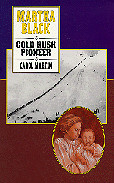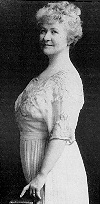


|
Martha Black: Gold Rush Pioneer.
Carol Martin. Subject Headings:
Grades 2 - 8 / Ages 7 - 13. **1/2 /4
|

It seems strange that a society woman like Martha would make plans to head for the remote and wild Yukon. But a kind of madness had seized the world, especially the United States, when the gold was discovered. The most unlikely people, knowing little about the country they were heading for or the problems they would encounter along the way, made plans to join the stampede.
 Martha Munger Black is another Canadian heroine who few people know
about. She was born into a well-off Chicago family, married Will
Purdy, who had a good future, and was the darling of Chicago high
society. Why would she give it up for the Klondike Gold Rush of
1896?
Martha Munger Black is another Canadian heroine who few people know
about. She was born into a well-off Chicago family, married Will
Purdy, who had a good future, and was the darling of Chicago high
society. Why would she give it up for the Klondike Gold Rush of
1896?
Carol Martin doesn't answer that question, but what she does do is
tell an exciting story about Martha's trip to the Klondike.
Through a combination of pictures, sidebars and text, we travel
with Martha from Chicago to Seattle, where we board a steamer to
Skagway, Alaska. From Skagway, we travel over the Chilkoot Pass on
foot and on to Dawson. We find out that Martha made this trip while
pregnant and we rejoice in the chivalry of the men of the camps.
After this trip, Martha went home but quickly returned and, in 1901, Martha
moved back permanently. Later, she met and married George Black, who became
Commissioner of the Territory and Member of Parliament for the Yukon and Speaker
of the House. Martha, too, had a successful life. She became a noted collector
of Yukon and British Columbia wildflowers. In 1935, she became a Member of Parliament
for the Yukon, occupying her husband's seat after he suffered a nervous breakdown.
She was a Fellow of the Royal Geographic Society and, in 1949, received the
Order of the British Empire. Martha Munger Black died in 1957.
In Martha Munger Black, Carol Martin has the perfect subject to
inspire young women. Unfortunately, she doesn't do it. Writing in
the now all too common "Sesame Street Style" - derived from the television
show where interest is rarely sustained longer than a few minutes,
and continuity is non-existent - Martin cannot
maintain any continuity in the story line.
I would recommend Martha Black's autobiography instead of this
biography. If you want a reason to read it, however, the
photographs by E.A. Hegg, especially of the Chilkoot Pass and the
trail of people climbing to the summit, are worthwhile. Then
again, you might want to visit the National Archives and see these
pictures there.
This book is recommended for those people, including children,
interested in learning more about their history and, especially,
about a woman's perspective on the Yukon.
Recommended with reservations.
Marsha Kaiserman is Head of Conferences Cataloguing at Canada Institute for Scientific and Technical Information (CISTI) in Ottawa.

To comment on this title or this review, send mail to cm@umanitoba.ca.
Copyright © 1996 the Manitoba Library Association. Reproduction for personal use is permitted only if this copyright notice is maintained. Any other reproduction is prohibited without permission.
Published by
The Manitoba Library Association
ISSN 1201-9364
AUTHORS |
TITLES |
MEDIA REVIEWS |
BOOKSHELF
BACK ISSUES |
SEARCH |
HOME